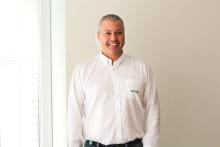
In a context where technology redefines equitable access to quality services, especially in the fight against cancer, the company seeks to promote the offer of equipment that includes AI for precise diagnoses and personalized therapies. The basis of their approach is early diagnosis as a fundamental change for governments and private health providers.
It's been two and a half years since GE transitioned from an equipment supplier to what it calls a 'health partner,' adopting the name GE HealthCare.
The spin-off, completed in January 2022, transformed it into an independent company valued at US$19.6 billion, with a presence in 160 countries and listed on the Nasdaq in New York.
“This 2024 we are focused on the people that healthcare serves, from professionals to patients,” explained Antonio Nasser, CEO of GE HealthCare for Latin America to AméricaEconomía .
Currently, the firm invests US$ 1,000 million in R&D ( Research and Development ), standing out worldwide in medical technology, diagnosis and innovation in digital solutions, the independent company is dedicated to providing integrated solutions, services and data analysis, “so that “Healthcare facilities are more efficient, doctors are more effective, therapies are more precise, and patients are healthier and happier,” adds Nasser.
The truth is that its plan is to continue expanding its range of products and services to address current clinical challenges, improve operational efficiency and alleviate the burden on healthcare professionals.
EMPHASIS ON EARLY DETECTION
GE HealthCare's diagnosis is that, in Latin America, the health sector experiences changes and fluctuations that can affect stability and predictability in the planning and management of resources.
Therefore, the challenge lies in guaranteeing equitable access for all citizens to quality health technologies and services, especially in countries like Chile, where cancer is the main cause of death since 2019, according to the Chilean Cancer Observatory. The conclusion is that in this and other diseases, an accurate and preventive diagnosis is required.
“It is a country with great opportunities to continue innovating and incorporating technologies and trends that aim to provide better diagnoses, increasingly more precise and with better quality images,” said Nasser, who was in that Latin American country for the seventh Congress. Theranostics World Cup, held in Santiago
The premise with which GE Health works is an approach that has gained strength in different countries.
“Medicine must increasingly focus on prevention as a fundamental change for governments and private health providers,” says Nasser.
This is because, as expected, the return on investment (ROI) in preventing diseases can be significantly greater than treating diseases once they occur.
“The growing emphasis on health care and the drive towards digitalization and automation of health systems in the region facilitate the work of doctors and improve the care delivered to patients,” says the CEO.
It is also GE Health's link between the public good and its value offering to the medical sector, based on detection and diagnostic equipment, which is constantly growing in sophistication.
These are artificial intelligence (AI) tools, for example, which - among other things - allow us to improve image reconstruction and, in essence, eliminate noise from raw digital data. This enhances the results with much clearer anatomical structures. In addition, progress has been made in reducing scanning times.
GE Healthcare claims to have 58 leading AI and machine learning (ML) technologies in the sector. What Nasser details is that, in addition, the differential lies in its ability to offer complete and personalized solutions that improve the quality of healthcare, especially in critical areas such as neurology and cardiology.
Additionally, they declare to be the only partner in the healthcare sector with comprehensive solutions for oncology and immuno-oncology.
“When we think about recent technologies launched globally, Latin America appears as one of the first to adopt globally,” says Nasser.
In this sense, the region is one of the countries that leads the installation of so-called AIR Recon DL, a reconstruction based on a deep learning algorithm that improves the SNR - the acronym in English for “ Signal-to-Noise Ratio ”, which means signal-to-noise ratio - and the sharpness of the image, by suppressing underlying noise and so-called 'Gibbs ringing artifacts'.
“[These innovations] allow for shorter scan times and simultaneously higher spatial resolution and a higher signal-to-noise ratio,” Nasser says.
Although the technical language does not say much to the layman, it has to do with a better and faster diagnosis, where a 74% reduction is seen for feet in all MRI exams, dropping from 36 minutes to 9, from 62% for orbits, going from 1 hour and 3 minutes to 23 minutes, and 61% for a woman's abdomen, going from a 1-hour exam to one that lasts 24 minutes.
“Another customer, located in Brazil, had one of the best results using this software , performing 90 exams daily with a single MRI Signa PRIME, which is an MRI machine developed from a new magnet design. These are real examples of the relevance of AI to change the health sector for the better, increasing efficiency, productivity, expanding access and bringing more quality to the patient,” explains the CEO.
THE REVOLUTION OF THERANOSTICS
In the region, GE HealthCare has a unit dedicated to research and development that actively collaborates with startups and health professionals. This past year, the team has generated more than 25 academic articles that address needs and advances in the healthcare field, allowing GE HealthCare to contribute technological advances and innovative solutions to improve healthcare in the region.
And growth through precision care allows immediate growth across your entire portfolio.
For example, revenue in the second quarter was driven by molecular imaging and computed tomography, as well as magnetic resonance imaging, due to improvements in the supply chain, stable demand, new product introductions and the price, explained the executive.
“In 2023 we report revenues of US$19.6 billion. This represents an increase of 7% year-on-year and 8% in organic terms, presenting growth in all segments and regions where the company has a presence,” he explained.
The company expects its presence in markets to expand from US$84 billion in 2021 to US$102 billion by 2025, globally.
Meanwhile, she is committed to positioning the concept of theranostics in the medical field. Derived from the combination of therapeutics and diagnostics , it uses radioactive drugs to perform a crucial double function.
“Theranostics emerges as a revolutionary concept that merges diagnosis and treatment to offer personalized and effective care to patients with cancer and other diseases,” explains the CEO of GE Health Latin America.
Initially, theranostics uses radiopharmaceuticals that emit specific signals, such as positrons or Gamma radiation, to obtain precise images of the tumor and evaluate its extension with millimeter precision. This diagnostic phase not only identifies the presence of primary tumors, but also metastatic lesions that may not be easily detected with traditional methods.
Once the diagnosis is complete, theranostics takes it a step further by administering specific treatments through radioactive drugs designed to directly target the previously identified cancer cells. These treatments, which use Alpha or Beta emitters, allow for targeted therapy that minimizes damage to surrounding healthy tissues, unlike conventional methods that often affect areas not affected by the disease.
In the Latin American context, the implementation of theranostics represents a challenge and an opportunity. It requires significant investments in specialized medical infrastructure, such as cyclotrons for the production of radiopharmaceuticals and PET systems for advanced molecular imaging.
“At GE HealthCare we offer a complete suite [from research and development of new radiopharmaceuticals to the implementation of advanced imaging technologies and tracer production systems],” Nasser reports.
Thus, the firm considers that theranostics will be a game changer in precision medicine, in which we will see the limits of personalization in health change.
“With a renewed focus on precision and individualization of treatment, which will not only transform the way cancer and other diseases are addressed, but will also promote a significant shift in global healthcare towards a more patient-centered model.” , and less invasive,” concludes Nasser.










